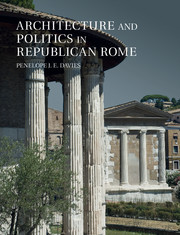Crossref Citations
This Book has been
cited by the following publications. This list is generated based on data provided by Crossref.
Davies, Penelope J.E.
2017.
A REPUBLICAN DILEMMA: CITY OR STATE? OR, THE CONCRETE REVOLUTION REVISITED.
Papers of the British School at Rome,
Vol. 85,
Issue. ,
p.
71.
Lawrence, Dan
2018.
New Book Chronicle.
Antiquity,
Vol. 92,
Issue. 362,
p.
556.
2018.
Books Received.
The Classical Review,
Vol. 68,
Issue. 2,
p.
615.
Hölkeskamp, Karl-Joachim
2018.
Mythen, Monumente und die Multimedialität dermemoria: die ‚corporate identity‘ dergens Fabia.
Klio,
Vol. 100,
Issue. 3,
p.
709.
Squire, Michael
2019.
Art and Archaeology.
Greece and Rome,
Vol. 66,
Issue. 2,
p.
312.
2019.
Roman Architecture and Urbanism.
p.
4.
Bellini, Giovanna R.
Goddard, Dominique
Grünwald, Daniel
Launaro, Alessandro
Leone, Ninetta
and
Millett, Martin
2019.
INTERAMNA LIRENAS AND ITS TERRITORY (COMUNE DI PIGNATARO INTERAMNA, PROVINCIA DI FROSINONE, REGIONE LAZIO).
Papers of the British School at Rome,
Vol. 87,
Issue. ,
p.
333.
Terrenato, Nicola
2019.
The Early Roman Expansion into Italy.
2019.
Roman Architecture and Urbanism.
p.
81.
Kontokosta, Anne Hrychuk
2019.
Building the Thermae Agrippae: Private Life, Public Space, and the Politics of Bathing in Early Imperial Rome.
American Journal of Archaeology,
Vol. 123,
Issue. 1,
p.
45.
Hölkeskamp, Karl-Joachim
2020.
Culture politique – carrière d’un concept.
Trivium,
Van Oyen, Astrid
2020.
The Socio-Economics of Roman Storage.
Johnston, Andrew C.
and
Mogetta, Marcello
2020.
Debating Early Republican Urbanism in Latium Vetus: The Town Planning of Gabii, between Archaeology and History.
Journal of Roman Studies,
Vol. 110,
Issue. ,
p.
91.
Tan, James
2021.
Republican Italy, inside out and outside in - K.-J. Hölkeskamp, S. Karataş, and R. Roth. 2019. Empire, Hegemony or Anarchy? Rome and Italy, 201–31 BCE. Stuttgart: Franz Steiner Verlag. Pp. 259, ill. 16. ISBN 978-3-515-11524-7..
Journal of Roman Archaeology,
Vol. 34,
Issue. 1,
p.
336.
Schreiber, Łukasz
2021.
KILKA UWAG NA TEMAT CENZURY KWINTUSA CECYLIUSZA METELLUSA MACEDOŃSKIEGO.
Zeszyty Prawnicze,
Vol. 21,
Issue. 3,
p.
81.
Brock, Andrea L.
Motta, Laura
and
Terrenato, Nicola
2021.
On the Banks of the Tiber: Opportunity and Transformation in Early Rome.
Journal of Roman Studies,
Vol. 111,
Issue. ,
p.
1.
Wiseman, T.P.
2021.
WALLS, GATES AND STORIES: DETECTING ROME'S RIVERSIDE DEFENCES.
Papers of the British School at Rome,
Vol. 89,
Issue. ,
p.
9.
WATANABE, Michiharu
2022.
<i>CAVEA</i> PLAN OF ROMAN THEATRES (PART 1) : UNTIL THE EARLY FIRST CENTURY B.C..
Journal of Architecture and Planning (Transactions of AIJ),
Vol. 87,
Issue. 793,
p.
656.
Tan, James
2022.
Political Cohesion and Fiscal Systems in the Roman Republic.
Frontiers in Political Science,
Vol. 4,
Issue. ,
Hopkins, John North
2022.
Engagements in and beyond Rome in the 5th c. BCE: architectural remains as evidence for action across geo-temporal boundaries.
Journal of Roman Archaeology,
Vol. 35,
Issue. 2,
p.
654.



